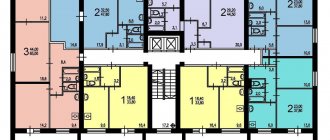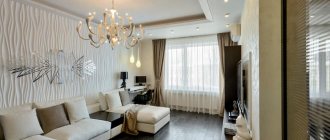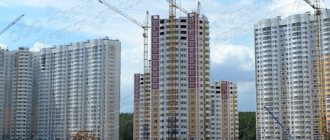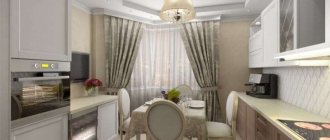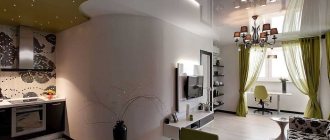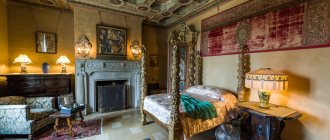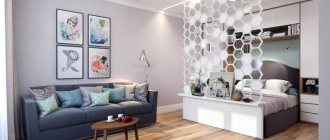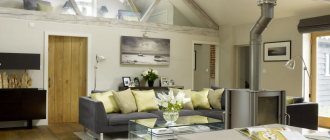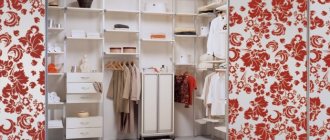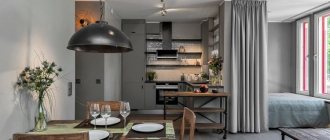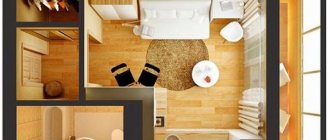Apartment layouts of series 1605 AM/9 and 1605 AM/12 with dimensions
Houses of the 1605 AM series, 9 and 12 storey versions, have completely identical apartment layouts.
There are various layout options in corner and rotary sections.
Plan of a 1-room apartment series 1605AM with dimensions:
Plan of a 2-room apartment of series 1605AM with dimensions:
Plan of a 2-room apartment series 1605AM with dimensions:
Plan of a two-room apartment of series 1605AM with dimensions:
Plan of a 3-room apartment series 1605AM with dimensions:
Plan of a 3-room apartment series 1605AM with dimensions:
Plan of a three-room apartment of series 1605AM with dimensions:
Plan of a three-room apartment of series 1605AM with dimensions:
Plan of a four-room apartment of series 1605AM with dimensions:
Plan of a 4-room apartment series 1605AM with dimensions:
Plan of a 4-room apartment series 1605AM with dimensions:
Plan of a 4-room apartment series 1605AM with dimensions:
Layout of a 3-room apartment in series 1605AM with dimensions:
You can find out more about the series here.
Source
The 1605 series of panel houses was approved during the Khrushchev Thaw, and the construction of the first versions of this series occurred in 1958-1966. a five-story series 1605 was designed . Houses of this series were built in Moscow, Odintsovo and Dolgoprudny. The floor height was accepted as standard for those times and was 2.5 meters.
The series was built from prefabricated transverse and longitudinal reinforced concrete panels with external hinged three-layer panels. Flat reinforced concrete floor slabs 140 mm thick rested on the internal load-bearing walls on three sides. and room size. Prefabricated reinforced concrete elements were produced until 1962 at the Gipstroyindustry trust, and after 1962 at House-Building Plant No. 1. The pitch between the load-bearing transverse walls was taken to be 2.65 and 3.4 meters. This series was distinguished by good economic indicators, ease of manufacture and installation of structures, clarity and clarity of static work. In the first projects, plank floors were used along joists, which is not typical for panel housing construction. the initial options did not provide for the installation of combined roofs; The design of the three-layer panels of the external walls was complex (the soft insulation from mineral wool slabs was compacted during the manufacture of the panels, which led to a decrease in the heat-insulating properties of the external walls); the nodal connections of the panels had the disadvantages inherent in large-panel housing construction in general, and over time they depressurized.
In the nine-story version, the ceiling height was increased to 2.64 m. The external curtain panels became expanded clay concrete. The building now has an elevator and a garbage chute. Nine-story versions of this series were built in 1966-72. in Moscow and Togliatti.
Source
Exterior decoration and design features of the series
The pile type of foundation for houses of modification 1605/12 simplified the implementation of “zero cycle” work, and the method of embedding joints between hinged external panels began to be used in the building design. This project provides for an improved ventilated roof, insulated over the entire surface with lightweight concrete. Roofing panels were already covered at the factory with a layer of roofing material for improved protection from precipitation. The plumbing cabins were entirely manufactured at the factory from moisture-resistant gypsum cement, and the plumbing risers were located outside the cabins. Prefabricated floor panels were also made from gypsum cement - they were made immediately in accordance with the size of the rooms on rolling machines designed for the production of interior partitions.
Some houses of this design were equipped with an experimental heating system - heating elements were placed inside the outer walls. However, such know-how in the future made it very difficult to maintain and repair communications, so later, in the process of renovating buildings, they were already installed according to a standard scheme.
House series 1605 am/12.
Load-bearing walls of the house series 1605/12.
Type of house – panel Number of floors – 9.12 floors. Apartments 1, 2, 3 rooms
Ceiling height - 2.64 m.
Developer - TsNIIEP Dwellings
Manufacturer - DSK-2
Years of construction : 1969-1985
Garbage chute - yes Building structures:
External walls are expanded clay concrete rolled panels 350mm thick.
Internal load-bearing walls are reinforced concrete panels 160mm thick.
Partitions - gypsum concrete panels 120mm thick.
Source
Features of apartment layouts
Series 1605/12 has small apartment areas, but they have a convenient layout. All apartments have loggias with an area of 2.5 m², 3 m² or 6 m². But the kitchens are quite small (about 6.6 m²), which is a significant disadvantage of the layout.
The thickness of the reinforced concrete panels of the internal walls is 160 mm, so it is impossible to make openings in them for redevelopment of the room. And the thickness of the plasterboard partitions between rooms is 80 mm, which is quite convenient for reconstruction.
Separate bathrooms are equipped with hoods that perfectly eliminate condensation.
Series 1605AM
With the presence of loggias at the ends, this series is reminiscent of II-49.
Photos of houses 1605 AM-12
Twelve-story buildings of the 1605 series were built until 1985, and the redevelopment of apartments in these buildings is very relevant.
Layout of a typical house section 1605-AM-12
Information about the location of load-bearing walls is very useful if redevelopment is planned. According to BTI documents, the location of load-bearing panels cannot always be clearly understood.
Houses series 1605 AM 12 in catalogs
The layout of the apartments has not undergone significant changes over the years of construction and has been replicated everywhere for 15 years.
Catalog and floor plan 1605AM-9
In the first nine-story building 1605, two elevators were installed, but later this practice was abandoned, leaving the second elevator only in the 12-story version of the houses.
Photos of houses 1605-AM/9
The kitchen area is small, from 6.5 to 7 square meters. m
The ceilings are quite high compared to their peers - from 260 to 265 cm.
Problems and solutions in houses of the 1605 AM series
First of all, the problem with all panels is the leakage of interpanel joints. Over the years, they have also been supplemented by cracks in the outer panels, which appeared in low-quality parts. The solution to the problem is a major overhaul of facades with their cladding and insulation.
Years have revealed problems with the heating system - in those houses where the heat exchanger of the heating system was made in the body of the panel, it was necessary to install risers and install standard radiators. Replacing windows with modern ones and glazing loggias has a positive effect on the energy efficiency of buildings.
Layout of apartments in houses of series 1605 AM
Panel houses of the 1605 series first saw the light of day in 1958. The first of them became a characteristic example of Khrushchev's architecture.
At first they were five-story, but in 1966 they developed a 9-story modification of this series. A little later, 12-story buildings appeared, which became one of the most popular buildings and were built throughout the country in those years.
The layout of the apartments in building 1605 AM, although far from perfect, has improved during the modification process.
Advantages of modification
There are no apartments with four or more rooms in this series. Only one-room, two-room and three-room apartments.
In the first houses, the ceiling height was 250 cm, which was normal by the standards of that time and was practiced by design institutes everywhere.
The 1605-AM series of houses, which were not Khrushchev but Brezhnev, already provided for a height of 264 cm.
As the number of floors increased, a passenger elevator and a garbage chute appeared in the buildings.
The walls of houses in this series were erected from three-layer reinforced concrete panels.
The internal enclosing structures here are load-bearing, since floor slabs, the size of which corresponds to the perimeter of the room, rest on them on three sides.
The ceilings are solid, only 14 cm thick, so audibility in the rooms is excellent.
A solid ceiling the size of a room is a typical design of panel houses
The first houses used wall panels with soft mineral wool insulation inside.
Over time, it compacted itself, and the thermal efficiency of the walls decreased. There was depressurization of the joints between the panels, which has always been a real disaster for buildings of this type. And the houses of the 1605 series are no exception.
There are a lot of panel houses, industrial climbers will not be left without work
The series was modified to improve the layout and eliminate design flaws.
In particular, a different technology for embedding joints was used. The panels themselves were no longer made of heavy concrete, but of expanded clay concrete, whose thermal conductivity coefficient was half as high, which meant that the houses were warmer.
Sizes of apartments and relative positions of rooms
The layout of the house 1605 AM is better than their Khrushchev predecessors.
Floor plan of one of the first five-story buildings:
Layout of apartments in houses of series 1605
But in houses of the 1605 AM/9 series:
Layout of apartments with dimensions 1605 AM
Options for kitchen layout for 6 m2 are presented in the article on our website.
True, in two and three-room apartments the increase in space is not so significant. In the houses of the 1605AM series there is one version of a one-room apartment, two two-room apartments and two three-room apartments.
One-room apartment
The house consists of two sections. Each of them has 4 apartments per floor, but only one one-room apartment.
Its layout is somewhat strange. The kitchen, which was enlarged compared to other apartments, was achieved by adding to it a part of the corridor that could not be used functionally. And in the kitchen there was an entrance to the toilet.
Layout of one-room apartment 1605AM series
This is both inconvenient and not very aesthetically pleasing. Therefore, many owners of such apartments decide to redevelop. One of the real options is presented below.
The purpose of the reconstruction was to combine and expand the bathroom, for which the partition between the toilet and the bathroom was removed and a piece of the corridor was added, making the entrance to the kitchen from the room.
Kitchen with access to the room, not to the hallway
The drawing shows an apartment with a balcony, the entrance to which has also undergone minor reconstruction. After dismantling the window-door unit, a piece of the wall was removed from the window sill area to install a display-type door.
Redevelopment option for a 1-room apartment
Wide glazed door improves insolation of the room
Options with two rooms
Both versions of two-room apartments
Here the bathroom is also separate, but both doors open, as expected, into the corridor, and not into the kitchen.
If you wish, you can do the same as in the one-room apartment - combine the toilet with the bathroom and a small corridor in front of them, moving the kitchen doorway to a perpendicular wall.
If you are going to combine the kitchen with the bedroom, then it makes sense to change the purpose of this room, making it a living room. Moreover, there is an opportunity to increase its area.
To do this, the room must be made rectangular, and the L-shaped part of the room must be connected to another room by dismantling the partitions.
General information.
The foundations are strip foundations made of prefabricated reinforced concrete blocks. The external walls of the basement are made of prefabricated reinforced concrete plinth panels with a thickness of 200mm and 250mm (end walls). The external walls of the 1st - 12th floors are made of expanded clay concrete panels with a thickness of 250mm and 300mm (in the entrance areas). Internal longitudinal and transverse load-bearing walls are made of prefabricated reinforced concrete panels 160mm thick. The external surfaces of the external wall panels have a painted textured layer of decorative concrete. The plinth panels are covered with ceramic tiles and painted. The floor and covering are made of prefabricated reinforced concrete slabs of “per room” and “half room” size, 140 mm thick. The slabs are supported on internal and external load-bearing walls. The covering is made of reinforced concrete roofing slabs with an air gap for ventilation. The slabs are supported on internal and external load-bearing walls. Internal two-flight staircases are made of prefabricated reinforced concrete flights and prefabricated reinforced concrete ribbed platforms. The steps are smooth concrete. The fence is made of a metal lattice 900 mm high with a plastic handrail. The roof is flat, atticless, combined, with a ventilated gap, rolled, with an internal drain. The rolled carpet is made of 2 layers of rolled fused material. The parapet is 600mm high, with an apron made of galvanized roofing steel. Metal fences along the front of roof superstructures (roof exits and machine rooms). Prefabricated reinforced concrete ventilation shafts. The covering of the ventilation shafts is made of prefabricated reinforced concrete slabs and galvanized roofing steel umbrellas. Access to the roof is carried out via a metal stepladder from the 12th floor level leading to the vestibule on the roof superstructure, from which, in turn, there is an exit to the elevator machine room and access to the roof. Organized internal drainage system. The windows of the apartments of the residential building are wooden, double sash, made of PVC profiles with double-glazed windows, metal sills. The windows of the staircases are wooden, single with double glazing with metal shimmers. The external doors of the entrances are metal, solid. The internal doors of the apartments are metal entrance, wooden panel and panel doors. The loggias are located on three sides of the building and are made of prefabricated reinforced concrete slabs 140 mm thick. The support is carried out on external and internal load-bearing walls. The fencing of the loggias is made of reinforced concrete panels lined with ceramic tiles. Most loggias are glazed. The entrance porches are made of reinforced concrete slabs lined with ceramic tiles. Over all entrances to the entrances there are canopies made of reinforced concrete slabs 200 mm thick, supported by external walls and a support made of reinforced concrete transverse wall in the middle of the canopy. The canopy is covered with soft welded roll materials. Entrances to the basement are located on the courtyard façade of the building. The walls of the descents to the basement are made of prefabricated reinforced concrete panels, 150mm thick. The entrance steps are prefabricated reinforced concrete. Asphalt blind area around the perimeter of the building. The garbage chute is built-in, closed, located in the stairwell between the elevator shaft and the outer wall. The garbage chute shaft is made of asbestos-cement pipes with a diameter of 400 mm. The building's central heating system is independent, connected to the heating network through a central heating station. The heating system is single-pipe with lower supply and return lines. Temperature chart 95-70°C. Piping runs through the basement above the floor. The risers of the system are laid hidden, without sleeves. Steel convectors are installed as heating devices. The connection to the heating network is independent. The supply and return lines are made of black pipes with a diameter of 12520 mm. The risers are made of black pipes with a diameter of 20 and are laid hidden. The input of 2tr Du150 is carried out with steel pipes along the facade of the building in the sixth entrance. Entry into the opening of the outer wall. The building has an integrated fire-fighting water supply system with a lower main line. Fire risers d=50MM, located on the staircase, are ringed on the 12th floor. The building is supplied with water from two inlets D=100mm, located in a pit near the outer wall of the technical basement. A water metering unit with a bypass line and a water meter of the BMX-65 brand is installed at the inlet. Cold water is supplied to the waste chamber room via a watering tap. The main pipeline after the water metering unit made of galvanized steel and partially black pipes D = 100-32 mm is laid under the basement ceiling. Risers and connections in bathrooms on floors made of galvanized steel pipes D = 32-15 mm are laid in sanitary facilities. cabinets. The building has a hot water supply system with lower supply lines and a circulation line. The building is supplied with water from inlets D=100.80 mm, located in a pit near the outer wall of the basement. Gate valves are installed at the inlet. A hot and circulating water metering unit is installed at the inlet. The supply distribution pipeline made of galvanized steel and partially black pipes D = 100-32 mm is laid under the basement ceiling; a circulation distribution pipeline made of galvanized steel and partially black pipes D = 80-32 mm is laid under the basement ceiling. Risers and connections in bathrooms on floors made of galvanized steel pipes D = 32-15 mm from galvanized steel pipes are laid in sanitary facilities. cabinets and looped under the ceiling of the 12th floor. Heated towel rails D=32, 25 mm are made of galvanized steel and stainless steel pipes and are connected to supply and circulation risers. Hot water is supplied to the waste chamber room from the circulation pipeline. The building has an internal sewerage system made of cast iron socket sewer pipes D = 150, 100, 50 mm. There is a ladder in the garbage chambers. Main pipelines made of cast iron pipes, partially replaced with HDPE pipes with outlets from each section to the yard network, are laid openly and partially hidden in the basement floor. Risers D=100 mm are laid in sanitary facilities. cabinets, risers in the technical underground are laid openly. Outlet pipes from sanitary fixtures made of cast iron pipes are laid openly above the floor of bathrooms and kitchens. All hoods of risers made of cast iron pipes D=100 mm are led out by the exhaust part above the roof level. The building has an internal rainwater drainage system made of electric-welded steel pipes D = 100 mm. Main pipelines made of electric-welded steel pipes with outlets to the blind area from each section, 1 outlet to the blind area. Drainage funnels with a sheet catcher are installed on the roof. Risers D=100 mm are laid in sanitary facilities. cabinets, risers in the technical underground are laid openly. The building has a natural ventilation system. Air flow is carried out through vents and leaks in window and door vestibules. Vertical exhaust ducts are installed in the structure of the internal walls in the bathroom. nodes and kitchens. Metal and plastic louvered ventilation grilles measuring 150x200 are installed in kitchens and bathrooms. Deflectors are installed above the waste chute shafts. Smoke protection system In order to protect escape routes from smoke during a fire, a smoke protection system is provided. Provision is made for installing a smoke exhaust valve at the top of the staircase. The exhaust shaft is concrete, located above the roof level. A black steel umbrella is installed above the smoke protection shaft. The location of the electrical panel is on the 1st floor, entrance 2 (ASU1) and entrance 6 (ASU2). Supply voltage is 380/220V. Input 1 VRU1-ASB 3x185 beam A from TP14937. Input 2 VRU1-ASB 3x185 beam B from TP14937. Input 1 VRU2-ASB 3x185 beam A from TP14937. Input 2 ARU2-2ASB 3x95 beam B from TP14937. ASU1 and ASU2 without standard markings (3 panels) size 1750x400x2000mm (WxDxH) - 2 sections. Non-standard floor panels. There are no group shields. The supply lines from the ASU to the main risers are open in the basement in metal pipes with copper wire, along the floors in existing embedded channels. Trunk risers are hidden. Group lighting networks for common premises - hidden, open in pipes. The lighting network of apartments is hidden. Lighting of staircases, halls, vestibules and building entrances is hidden with aluminum wire under a layer of plaster. Lighting fixtures with fluorescent lamps are installed. Basement lighting is open in steel pipes, corrugated hose. Yard lighting - illumination of the yard area with lamps on Mossvet poles.
